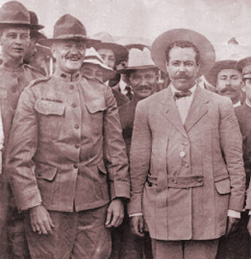
News this week of General Stanley McChrystal’s indiscretions came 94 years to the day – June 21, 1916 – that the U.S. military “punitive” expedition in pursuit of Pancho Villa was attacked by Mexican troops at Carrizal, Mexico.
The expedition was under the command of Brigadier General “Black Jack” John Pershing, whose aide, George S. Patton, would be relieved from his command of the U.S. II Corps 27 years later, for his own indiscretions (although he would later be given command of the U.S. Third Army).
During the 1916 march from New Mexico to Colonia Dublan, Mexico, Patton would note in his memoir, Pershing covered 120 miles in 30 hours on a borrowed artillery horse. The first halt, 30 miles into Mexico near a pile of boulders, was the same spot where Pershing had commanded a troop of U.S. Indian Scouts against Apaches in 1886.
Patton, an avid horseman who kept a stable of Thoroughbreds and polo ponies, played a major role during the last days of the WWII in evacuating a group of valuable Polish Arabians to the U.S., where they were relocated to a remount station in Pomona, CA, home of the famous Kellogg Arabians.

Included in the Polish importation was *Witez II, one of three young stallions sired by Ofir, who had already been removed to the Russian State Farm at Tersk.
During this time, newspaper magnate William Randolph Hearst also maintained a large herd of Arabians at his San Simeon Estate and in 1947, he hired Patton’s former farm manager (Patton died in December 1945), Preston Dyer, as San Simeon’s stud manager.
Witez II, foaled in 1938, would live another 20 years in the U.S. and sire many champions before his death in 1965.
